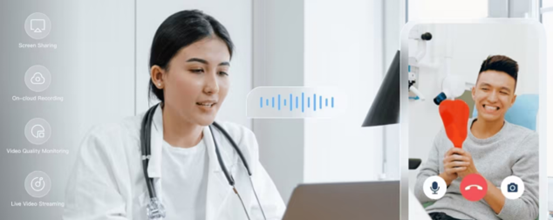The advent of telehealth, fueled by
advancements in technology, has transformed the healthcare landscape. Among the
various telehealth modalities available, video chat has emerged as a powerful
tool with a multitude of benefits. It not only bridges geographical gaps but
also enhances the quality and accessibility of healthcare services. In this
article, we will explore three key benefits of using video call in telehealth.

1. Making
Medical Resources Accessible Worldwide
One of the most significant advantages of
video chat in telehealth is its ability to make medical expertise and resources
accessible from anywhere in the world. Geographic barriers are no longer an
obstacle when patients can connect with healthcare professionals through a
video call. This accessibility has several implications:
- Specialized Care: Patients in remote or
underserved areas can access specialized medical care that may not be available
locally. They can consult with experts from renowned medical centers, ensuring
they receive the best possible treatment and advice.
- Second Opinions: Video chat allows
patients to seek second opinions from multiple healthcare professionals without
the need for extensive travel. This can be invaluable in complex medical cases,
providing patients with a broader perspective on their condition and treatment
options.
- Global Collaboration: Medical
professionals can collaborate across borders to share knowledge, discuss cases,
and provide comprehensive care. This global collaboration enhances the quality
of care and fosters innovation in the field of medicine.
2. Enabling
Online Medical Consultation
Video chat facilitates real-time online
medical consultations, which offer several advantages:
- Convenience: Patients can consult with
healthcare providers from the comfort of their homes or workplaces. This
convenience eliminates the need for long commutes and waiting room delays.
- Reduced Healthcare Costs: Online
consultations often come at a lower cost than traditional in-person visits.
Patients can save money on transportation, parking, and other associated
expenses.
- Continuity of Care: Patients with chronic
conditions can benefit from regular online check-ins with their healthcare
providers. This ensures continuity of care and allows for timely adjustments to
treatment plans.
- Immediate Care: Video chat can be
especially beneficial for urgent medical issues. Patients can receive prompt
attention from healthcare professionals, leading to faster diagnosis and
treatment.
3. Enhancing
Interactive Medical Education
Video chat also plays a pivotal role in
interactive medical education. Here's how:
- Remote Learning: Medical students and
professionals can participate in remote medical education programs, workshops,
and seminars. This access to knowledge transcends geographical limitations and
encourages lifelong learning.
- Case Discussions: Video conferencing
enables medical professionals to engage in case discussions, peer reviews, and
collaborative learning. This collaborative approach to education enhances
diagnostic and problem-solving skills.
- Patient Education: Healthcare providers
can use video chat to educate patients about their conditions, treatment options,
and self-care practices. Visual aids and interactive sessions can simplify
complex medical information, empowering patients to make informed decisions
about their health.
4. Supporting
Video First Aid
Video chat can also be utilized for
providing immediate first aid assistance, especially in emergencies or
situations where professional help is not readily available. Laypersons can
connect with healthcare professionals or receive guidance on administering
basic first aid measures until help arrives.
5.
Post-Discharge Follow-Ups
Video chat enables healthcare providers to
conduct post-discharge follow-up appointments with patients. This proactive
approach ensures that patients are recovering well, following their treatment
plans, and addressing any concerns or complications promptly. It can
significantly reduce hospital readmissions and improve patient outcomes.
Conclusion
In conclusion, video chat has
revolutionized the field of telehealth, offering numerous benefits that extend
beyond the traditional healthcare model. The Tencent live chat API can help a
lot. By making medical resources accessible worldwide, enabling online medical
consultations, enhancing interactive medical education, supporting video first
aid, and facilitating post-discharge follow-ups, video chat is ushering in a
new era of patient-centered and accessible healthcare. As technology continues
to advance, we can expect video chat to play an increasingly pivotal role in
shaping the future of telehealth, ultimately improving healthcare outcomes and
patient experiences worldwide.
